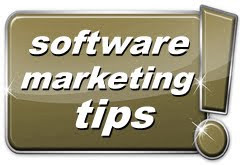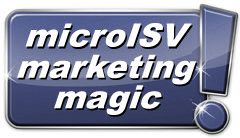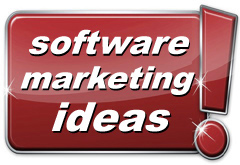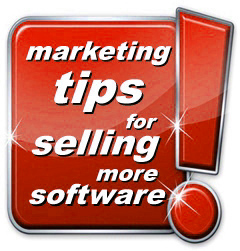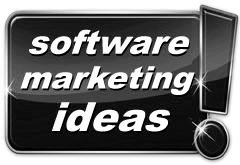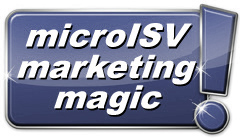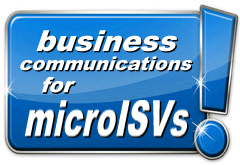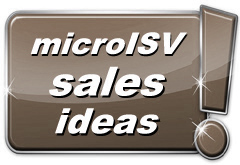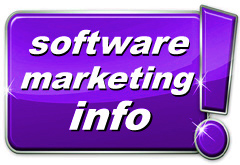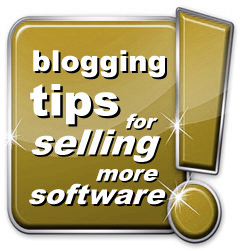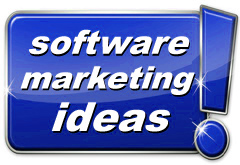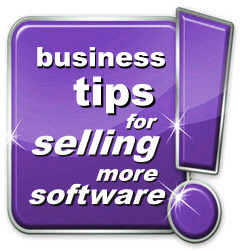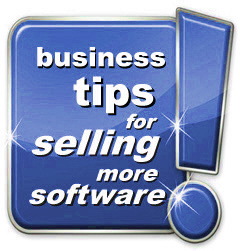Small, independent software vendors (microISVs) can sell more of their software if they make it simple for prospects to learn the price. If you hide the price, your website visitors won't be reading the marketing presentation on your website. Instead, your web site visitors will be scrolling and clicking, trying to learn how much you charge for your program.
Paco Underhill, in his book "
Why We Buy – The Science of Shopping," tells us that shoppers in brick-and-mortar stores dislike obscure or hidden price tags. The same distaste for hidden prices carries over to the Internet. I believe that Underhill would be urging software developers to make it easy for prospects to find their pricing information.
Software price and differentiation
Lots of microISVs use their software's price to differentiate their applications from their competitors' programs. According to Jack Trout, the author of "
Differentiate or Die," price can rarely be an effective differentiating tool. In fact, Trout believes that price can be the enemy of differentiation.
As soon as you talk about price, Trout tells us, people assume that you're not able to state why your product or service is different from – and better than – your competitors. So, it's best to avoid competing on price.
If you should decide to compete on price, then be sure to have an integrated theory on how price and value are merged together to provide something unique. Trout provides a number of examples of companies who have merged price and value into a cohesive sales message:
- Southwest Airlines used this strategy with their low ticket prices plus a system of hubs in smaller municipalities. They offered lower prices, and they justified their ability to offer bargains to their customers.
- Wal-Mart succeeds with low prices, plus store locations in smaller towns (versus in larger cities with their higher costs of living), plus vendor contracts that support their lower prices.
- For years, Dell used affordable prices along with direct sales to succeed.
Price alone is not a good basis on which to compete. But price plus something else – something that makes a low price logical – can be an effective way to differentiate a product or service.
Responding to competitors' software price decisions
If you have a competitor who is denting your sales by lowering the price of their software applications, then there are some strategies that you can use to deal with the problem. Here are three of Trout's suggestions, translated into the software development industry:
- Do something odd. Don't simply cut your price to match a competitor's. Instead, create a software bundle, or find a non-price way to change what you're offering to your customer base.
- Confuse the marketplace. Trout points out that that's what MCI did when they launched their "Friends & Families" discount program. MCI made it very difficult for prospects to tell if their pricing would be higher or lower than, say, AT&T's more traditional long-distance pricing.
- Change the discussion. Admit that your software costs more to buy initially, but tell your customers that you offer deeply-discounted upgrades for the first two years. Talk about the total cost of ownership (TCO), and how your software pricing results in lower long-term expenses. Discover a way to change the discussion from initial price to overall cost for the life of the software.
Marketing and low software prices
Trout argues that price reduction sales are bad for businesses. He doesn't believe that sales bring in incremental income in the long run.
Sergio Zyman, author of "
The End of Marketing As We Know It," believes that discounted prices are a sign of marketing laziness. Price cutting is what lazy marketers do when they can't think of any creative marketing ideas. "When a price promotion ends," Zyman tells us, "the consumers move on to the next guy who's willing to pay them to buy his product."
Trout talks about an example of low prices in the sports retailing business. The four biggest sports retailers were all losing money. They'd all been competing on price. And when Wal-Mart and Kmart got to the point where they were selling 35 percent of all sports equipment in the US, the major sports retailers could no longer maintain viable margins.
Trout is not a supporter of the "free" trend that has become so popular in the software development industry. His belief is simple: It's tough to give away products or services for free, and still make a profit.
Can microISVs succeed with a high-price strategy? Lots of consumers believe that the highest quality products should cost more. And people are willing to pay for products that they believe will impress their friends and family. A high price, Trout tells us, becomes a benefit of the underlying product because it impresses the buyers' coworkers and colleagues.
Lowering prices is not a good long-term marketing strategy. So says Philip Kotler, author of "
Kotler On Marketing – How to Create, Win, and Dominate Markets." At the time Kotler penned this book, he had sold more than three million marketing textbooks, and done marketing consulting work for Fortune 100 companies including AT&T, General Electric, Ford, and IBM. Professor Kotler knows a lot about marketing.
Kotler tells us that the marketing pro's who attend his seminars believe that their customers are more sophisticated than they were in prior years, and more price-sensitive. At the same time, these attendees believe that dropping your products' prices doesn't work because competitors respond in kind, and everybody loses.
Kotler argues that it's a mistake for a business to price its product based on a mark-up. Your prospects and customers don't care how many hours it took you to write the program, or how much you paid for the programming tools that you deploy. Instead of using a mark-up method of pricing, software developers should base their prices by figuring out the value of the application to their software-buying customers.
Branding and pricing are connected, Kotler tells us. Marketing is all about building a brand. If you don't build a brand and differentiate yourself from your competitors, then you're selling a commodity. There is only one way to differentiate yourself in a commoditized market, and that's by lowering your prices.
Software pricing and marketing strategy
Determining the price of your software is a vital component of your marketing strategy. Avoid using a simple definition of price. Your strategy should take into account the software's list price, site license discounts, allowances, coupons, credit terms, affiliate fees, and commissions, as well as any bundled products or services that you may be offering.
Developers often ponder if it is wise to offer a low-priced personal license and a higher-priced business license, for identical software. Some consumers may be offended by the idea. On the other hand, consumers see this kind of pricing every day.
For example, if you go to a concert, you'd expect to pay more for seats that are closer to the stage, even though the seats cost no more to manufacture or install than those seats that are in the back of the auditorium. Similarly, most consumers expect to pay more for weekend tickets than for weekday tickets. The concept of identical software being sold at different prices to different audiences isn't bizarre, but you have to craft a convincing sales message for all of your prospects.
Kotler urges business people to add value to the more expensive version of our products and services. You could offer priority support, or coupons, or long-term discounts to the customers who purchase the business license. The solution is to create a series of attractive offerings at a range of price points.
Software pricing and repeat customers
Developing long-term customers delivers advantages to microISVs. You can cross-sell and upsell to your long-term customers. It takes considerably less effort to complete transactions with them because they're familiar with your software, communications, emails, and procedures. Long-term customers are more likely to recommend your programs to their friends and colleagues.
But there is also a pricing consideration. Long-term customers are less price-sensitive because they've developed a relationship with your microISV firm. They may even pay a little more for your software because they trust you, and because they're comfortable buying from your company.
Kotler tells us to use pricing as a way to manage difficult customers. Most firms lose money on some percentage of their worst clients. If you're getting customers who need too much hand-holding and technical support, for example, find out why they're buying from you, and do something to make your company less attractive to these difficult prospects. If you want to keep these customers, then find a way to educate them so you're not spending too much time delivering support services. Alternatively, raise your prices to these prospects so it becomes worthwhile to deal with them.
Marketing with higher software prices
Advertising genius David Ogilvy shares some ideas on maintaining high prices in a price-sensitive marketplace. In his book "
Ogilvy on Advertising," Ogilvy said to his prospects, "If you are going to choose your agency on the basis of price, you are looking through the wrong end of the telescope."
Ogilvy urged his prospects to concentrate on the increased sales that his advertising agency could deliver, and not the amount of fees that he charged. This approach can also be effective in marketing software on the Internet.
Don't price your software too low. Ogilvy mentioned that people judge the value of a product by its price. I agree. I've said for years that too many software developers price their applications too low, and it damages their profits.
Harry Beckwith, the author of "
The Invisible Touch – The Four Keys to Modern Marketing," agrees that low prices are not the answer to business success. Beckwith believes that higher-priced goods and services are perceived to be better than lower-priced alternatives. Price changes perception. In fact, price can actually enhance the experience of using a product or service.
"Higher prices don't just talk," Beckwith insists. "They tempt." My nearly 30 years of marketing experience in the software development industry confirms Beckwith's belief. In the software industry, most developers will tell you that their Pro version outsells their Standard version.
Beckwith says that price is often the excuse (but rarely the reason) that you're losing market share to your competitors. "Look deeper," he recommends. Most people can afford to pay more money for your software application. Don't lower your prices. Instead, do a better job of convincing prospects that your applications have more value than the software that your competitors are marketing.
Pricing your software application
There's no shortage of advice on how to set the price for your applications. And there is no simple formula for arriving at the perfect price-point. Take into account all of the factors discussed above, take your best guess at the right price, and measure your sales results. Then, change the price and measure again.
If in doubt, raise your prices. Based on my work with microISVs, you're probably charging a little less than you should be asking.
 Always include your brand name in the headline of your ads. So says Jeffrey J. Fox, the author of the book "How to Become a Marketing Superstar - Unexpected Rules that Ring the Cash Register."
Always include your brand name in the headline of your ads. So says Jeffrey J. Fox, the author of the book "How to Become a Marketing Superstar - Unexpected Rules that Ring the Cash Register."

